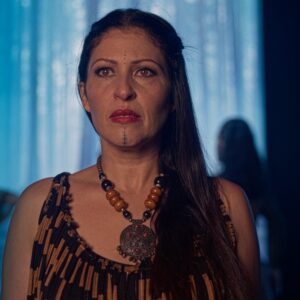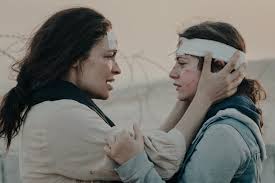In the second episode of the new season of the popular Emmy-winning series Succession, Jeremy Strong, playing Kendall Roy, son of the billionaire media mogul Logan Roy, seriously suggests that a “semi-pitch” for a media company could have a focus on Africa. “Just what is happening in Africa—the Maghreb, Sub-Saharan East, Sub-Saharan West,” he says. He’d watch it. His siblings object, but he continues. “The point is its global reach. It’s a network that teaches you how to watch it,” he says. Succession is an HBO show but if the guys at Netflix did put such a pitch in their emails, they would pass on it. Why? Because they were there first.
In 2021, Netflix partnered with UNESCO, the U.N. Educational, Scientific and Cultural Organization, and announced a contest involving filmmakers from across Africa producing short films. The results aren’t quite what one expects from news media content, but part of the nature of productions of this sort, whenever it concerns Africa, is to have something newsy, something socially relevant, something clearly political. And where UNESCO is involved, it is reasonable to expect something very native.
That is not a theme superimposed on the results of the competition; it was embedded in the name of the contest itself: African Folktales Reimagined. The idea was for filmmakers is to take an ancient tale, probably told to them as kids, and bring it forward.
At the time of the contest, it sounded as though filmmakers were asked to bring these tales into the present day. But the release of the half-dozen short films saw at least one filmmaker, Korede Azeez, set her story in the future. But in such a way that it is connected to the present.
Halima’s Choice, as directed and written by Azeez, takes a popular folktale across Nigerian cultures back in the day, adding some AI and metaverse talk to it. The original story involved a headstrong girl who refuses her parent’s choice of a suitor. Instead, she chooses a good-looking stranger from a distant village. As she follows her groom to her new home, she is surprised and shocked that at intervals he returns parts of his body which, it seems, he had borrowed to impress her. When the real “man” emerges, lo and behold, he is not human. The lesson, as far as one can easily tell, is that kids need to obey their parents—and maybe that not everything shiny is good for you.
Azeez adds a feminist slant to the tale and rather than have a distant village, we have Napata, a virtual world where everyone but a handful of people have “migrated” to. The people in Gidanpula are displeased with the idea of this migration and are super-wary about admitting people into their community. So when a stranger arrives unconscious at the outskirts of their village, they search his body for any sign he is one of the people from Napata before letting him in. What they don’t bargain on are the ways of a young woman’s heart.
The love affair is never really shown, save for a couple of chaste chats and an exchange of smiles, but some affection is established. It’s too early to say whether Azeez possesses the spark of genius, but her short demonstrates a firm hand and is quite a departure from the predominant aesthetic of mainstream cinema in Nigeria. There is barely a hint of melodrama, the colour palette is muted, and the sound design is subtle but enriching. Her cinematographer, Baba Agba, gets a few beautiful shots, notably as the film closes.
Azeez belongs to a different cinematic tradition from Loukman Ali, the Ugandan director of Katera of the Punishment Island. Where her world, which in some ways is post-apocalyptic and could borrow from any number of popular films, is decidedly non-Hollywood and devoid of pop action, his is very much steeped in the tradition of action films. The story itself is a bit like Kill Bill, if both Bill and the Bride were not exactly lovers and came to the story with a healthy dose of melanin.
Ali begins his tale with a prologue about pregnant women getting dumped on an island because they got pregnant. But after she is rescued, Katera is unable to let go of the trauma of her experience. She decides to revenge herself and goes to face the enemy.
Ali is already one of the more obvious talents in African cinema today. His country, Uganda, is not exactly the first country that comes to mind when one thinks of modern African cinema, but the man has been such demand that he was hired to direct a film in Nigeria, a highly uncommon practice in Nollywood. The final cinematic product of that decision, Brotherhood, became one of Nigeria’s highest grossing films. And yet, Katera is not his strongest short film work.
For that, you would have to go to his YouTube page. The plot isn’t bad, but it’s a familiar story. The story seems woven around a couple of set pieces Ali wanted to bring to life on a Netflix budget. Nothing wrong with that approach if it the story then works spectacularly. In this case, that isn’t the case. But as followers of his work will come to expect, he serves up a visual feast and there is one sequence at the end of the film that will remind his fans of his quality. If there is any African director from the Sub-Sahara with Loukman Ali’s vision and skill for action set pieces, he is yet to emerge.
These two films are the longest films in the anthology. They are also the most narratively substantial. The film from Kenya, Anyango and the Ogre, is a slight picture centred around a family with a violent father. It wears its domestic violence theme on its head, and its main conceit is a juxtaposition of the horrors of a vicious patriarch with a fictional ogre terrorising kids in a storybook. Director Voline Ogutu cleverly deploys the call-and-response songs familiar in African songs, but the film itself is unlikely to be remembered long after the credits.
From South Africa comes MaMlambo, a tale that takes place mostly in a single scene. Depending on who you ask, the title refers to a goddess or a monster or both of those things. It lives in the rivers and is similar in some regard to Mami Wata, which itself has received recent cinematic treatment in a film that received its African premiere at FESPACO in Burkina Faso. In MaMlambo, it is portrayed by a woman who takes care of a younger woman who has just attempted suicide. The film makes a point about gender-based violence and is talky. Those expecting to see a great filmic monster might be surprised, as it appears that part of director Gcobisa Yako’s remit is portraying the goddess as a female benefactor, one despised because of the greed of humans. But, of course, one short film won’t do the trick.
At 13 minutes, the shortest film of the collection is Katope, which is also from East Africa and directed by Tanzania’s Walt Mzengi. Another narratively slender picture, it follows the eponymous child, who is made from earth and, for those familiar with the original folktale, not supposed to be caught under the rain. Netflix’s resources ensure that the film is technically astute, but placed alongside the first two films discussed here, its shortcomings, partly because it’s indeed short, are a bit obvious. Nonetheless, it has a striking final shot.
The sole film from the Sahara is Mohamed Echkouna’s Enmity Djinn, an understated but superb telling of a very subdued confrontation between one woman and a djinn. The pair first meet when the woman is a child. Then, 75 years later, they meet again. As in their first encounter, someone with malevolent eyes has invited the djinn. It is never explicitly stated, but it may be the case that the first meeting ended favourably for the child because of her innocence. Thus, one question that is forcefully raised is this: what will the adult turn to?
Taken together, the collection offers different views of Africa’s filmmaking. It is not a very true picture, because while all of these films are well-done from a technical perspective, the constraints presented by the individual countries are likely to be why they look and sound the way they do. Here, even if the filmmakers have different visions, the production quality and centrality, as mediated through supervising producer Steve Markovitz’s Big World Cinema, offers unity of sorts. The hope is that all six chosen directors have received an adequate introduction into what film production at the Netflix level is like—and can now take this knowledge to projects made in their own idiom. The birds have been fed. Now it’s time to fly.
If they fly as well as they can in their own ways and go far, maybe even Kendall Roy will understand that Africa can tell its own stories, all by itself.

.png)






av6wie
Rattling excellent info can be found on blog.Blog money